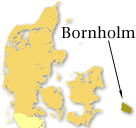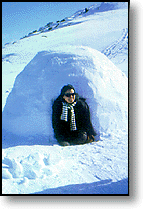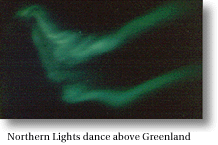An Introduction to Denmark
What To See in Denmark:
![]()

Selected Regions:
COPENHAGEN and NORTH SEALAND
FUNEN and the ISLANDS | BORNHOLM
Greenland

Geography
| Greenland
is the largest island in the world. Its northerly location,
at the point where the Atlantic meets the Arctic Ocean, means
that Greenland is surrounded principally by cold ocean currents,
so the coasts are constantly being cooled. This, combined with
the radiation of cold from the inland ice, gives Greenland
its arctic climate. The ice cap or inland ice covers 1,833,900 square km, equivalent to 85 percent of Greenland's total area, and extends 2,500 km (1,553 miles) from north to south and up to 1,000 km from east to west. |
At its center, the ice can be up to 3 km thick, representing 10 percent of the world's total fresh water reserves.If all the ice were to melt, the world's oceans would rise seven meters.
Climate
Greenland is often associated with cold and darkness and it can, of course, get very cold. However, there is also plenty of light and, although the polar darkness often reigns (in Qaanaaq, the sun doesn't rise for a whole three months!), it is never totally dark. Greenland enjoys more hours of summer than anywhere down south, but the weather is nowhere near as warm, even though the light is much more intense. Greenland summers won't give you an all-over tan, but your face and neck will turn a beautiful shade of brown.
The climate of Greenland is generally dry, and this means that the same temperature feels very different in Greenland from what it does in Europe. 10 - 15 C (50 - 60F) seems very warm, while -10C (-50F) seems a very pleasant temperature.
People
 People
have lived on Greenland for about 5, 000 years, the earliest belonging
to what are called the Independence I , Saqqaq, and Independence
II cultures. They migrated from North America, used stone tools,
and were the first to successfully adapt to the island's severe conditions.
Following the Independence II migration, a people known as the Dorset
arrived, and it is from them that the oldest myths and legends of
Greenland's modern day Inuit people are derived. The Thule, who are
closely related to the Inuit, arrived in about 900 AD, just before
the first Norsemen began settling on the eastern and southern coasts.
Today, 80 percent of the island's people are Inuit; the rest are
Danish.
People
have lived on Greenland for about 5, 000 years, the earliest belonging
to what are called the Independence I , Saqqaq, and Independence
II cultures. They migrated from North America, used stone tools,
and were the first to successfully adapt to the island's severe conditions.
Following the Independence II migration, a people known as the Dorset
arrived, and it is from them that the oldest myths and legends of
Greenland's modern day Inuit people are derived. The Thule, who are
closely related to the Inuit, arrived in about 900 AD, just before
the first Norsemen began settling on the eastern and southern coasts.
Today, 80 percent of the island's people are Inuit; the rest are
Danish.
Recent History
Backed by the Danish kind, Hans Egede, a Norwegian priest, organized a successful expedition to Greenland in 1721. This expedition began the colonial age, which lasted until the constitutional amendment of 1953. Since then, Greenland has had a home-rule government under normal Danish rule, and (like the Faroe Islands) Greenland also became entitled to send two representatives to the Folketing, or Danish Parliament.
As Danish citizens, the Greenlandic people now had ordinary civic right and their general state of health and educational facilities was radically improved.
Flora and Fauna
The richest plant growth is found in the sub-arctic belt, which includes only the very southernmost part of Greenland and the inner fjords. The greater part of Greenland, however, has diverse mountain vegetation, reminiscent of northern Scandinavia. In the driest inland areas, the vegetation is similar to that found in the mountainous regions of central North America.
Among the many different types of whale in the waters of Greenland are the fin whales, blue whales, humpbacks, narwhal, white whales, lesser rorquals, sperm whales and pilot whales. On a whale watching trip, it isn't unusual to see two different species, and meeting a humpback with a tail up to 5 meters wide is an experience to be remembered.
Northern Lights and Midnight Sun
The
Northern Lights appear all year round, but they are most impressive
in the
autumn months. They can also be seen in March and they "disappear" in
the light summer nights. 
The midnight sun is another magnificent Greenland phenomenon which is encountered north of the Arctic Circle. Daylight can be enjoyed round the clock, depending on how far north you are. For example, in Uummannaq, the midnight sun is present from the 16th of May to July 28th and during that time "normal" methods of working out what time it is are more or less useless. It is light around the clock.
Traveling to Greenland
Greenland is reached by air from Copenhagen. Booking in London:
- SAS, Tel: 0171-734 4020
Copenhagen-Sdr. Stromfjord, 3 weekly, duration: 4h 50m
APEX return DKK 4,545Icelandair, Tel: 0171-388 5599
Copenhagen-Narsarsuaq via Iceland, 4 weekly, duration 1h30m + 3h,
APEX return DKK 4,590 (Summer 1996)
Touring Greenland, visitors use ships along the coast or helicopters and conventional aircraft.
Further information about Greenland is available from:
Greenland Tourism
a/s P.O. Box 1139 DK-1010
Copenhagen K Denmark
Tel: 45 33 13 69 75
Fax: 45 33 93 38 83
To the north, the coastline becomes more rugged, with lovely sandy coves nestled like small oases amid dramatic rock formations.
All along this coast lie Bornholm's many small communities--small fishing villages and coastal towns that slumber peacefully for most of the year, only to come alive with festivities during the summer months. In addition to the local harbour and summer fźtes, a variety of establishments around the island offer live music, including jazz, rock, pop, and other entertainments as well as traditional church concerts. The numerous beautiful old churches of Bornholm are themselves of great interest, and along with smoked herring and the Hammershus castle ruins Bornholm's "four round" churches are an integral part of the island's image.
To the east end of Bornholm lies Ertholmene, Denmark's easternmost island cluster. More than 300 years ago a fortress was built on the two main islands of Frederiksų and Christiansų, though it was rarely a scene of battle. The Ertholmene fortress was abandoned in the 1860s, and ever since the two islands have served as home to fishermen and to artists drawn to the island's unique atmosphere and beautiful surroundings.
The natural diversity and the beautiful towns and buildings of Bornholm have been inspiring artists for even longer. For more than 150 years the island's extraordinary light--a consequence of Bornholm's situation in the middle of the Baltic Sea--has captivated the painterly eye. The island's Art Museum exhibits works from many of the artists of the Bornholm school of art.
Among the diverse activities offered on the island, fishing and golfing have become particularly popular. Bornholm has three good, well-kept, and vastly different 18-hole golf courses, all located within 25 kilometres of each other. For many of the island's guests, the highlight of a visit is a long anticipated and highly dramatic struggle with a wild Bornholm salmon or sea trout. With more than 100 kilometres of coastline, an undisturbed spot to cast your line is always available.
Bornholm offers accommodations suited to every taste and pocketbook, from camp sites, youth hostels, and bed & breakfasts to hotels, holiday villages, and holiday cottages. It is even possible to stay on one of the island's picturesque farms.
Copyright
1997 - 2005 InterKnowledge Corp
all rights reserved
